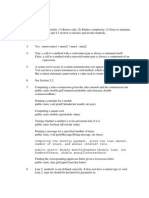java-exercises-1 (1)
Uploaded by
Sureshjava-exercises-1 (1)
Uploaded by
SureshCreate the java project in Eclipse
Java Project: core-java-excercise-1
Packages:
1. com.ey.util
Class Name: MyMath ( Utility classes)
Methods:
1. public static boolean isPerfectNumber(int n);
a perfect number is a positive integer that is equal to the sum of
its positive divisors, excluding the number itself.
all its factors except the number itself, returns true if the given
number is a perfect number else returns false
2. public static long factorial(int n);
returns factorial of the given number
3. public static boolean isPrime(int n);
4. public static long sumOfPrimes(int n);
returns sum of primes numbers between 1 to n.
Note: Invoke isPrime() within this method
5. public static boolean isArmstrongNumber(int n);
returns true if the given number is armstrong number else
returns false.
if number is 3-digit number say "xyz", armstrong number is
xyz==cube of x+cube of y+cube of z
// int->String (String.valueOf(int)) -> StringBuffer->reverse()->String-
>int (Integer.parseInt())
6. public static int reverseNumber(int n);
returns reverse number of the given number
7. public static int decimalToBinary(int n);
receives decimal number and returns its binary form
8. public static int binaryToDecimal(int n);
receives binary number and returns its decimal form
9. public static int getSumOfNfibos(int n);
returns sum of n fibonacci numbers.
Ex. n=10
0 1 1 2 3 5 8 13 21 34
0+1+1+2+3+5+8 + 13+21+34 = 88
10. public static boolean isPalindromeNumber(int n);
Ex. 1991 is a palindrome number
2. com.ey.ui
Tester Class Name: MyMathDemo
Test the methods of MyMath class
You might also like
- Capgemini Pseudo Code Questions With AnswerNo ratings yetCapgemini Pseudo Code Questions With Answer21 pages
- Java Technical Programming Questions With AnswersNo ratings yetJava Technical Programming Questions With Answers27 pages
- Class-11-Chapter-3. Python Data HandlingNo ratings yetClass-11-Chapter-3. Python Data Handling4 pages
- Triangular Numbers: Finding The NTH Term Using A LoopNo ratings yetTriangular Numbers: Finding The NTH Term Using A Loop5 pages
- C Programming Function Problems CorrectedNo ratings yetC Programming Function Problems Corrected6 pages
- Python (PCC-CS393) : IT2 Year, 3 Semester, Year:2020 Assignment-2No ratings yetPython (PCC-CS393) : IT2 Year, 3 Semester, Year:2020 Assignment-21 page
- ECE244H1_20179_631571720330Midterm_2017No ratings yetECE244H1_20179_631571720330Midterm_201725 pages
- Computer Science Assignment Name: Aditya Krishna Das Class: XI Roll No.: 2No ratings yetComputer Science Assignment Name: Aditya Krishna Das Class: XI Roll No.: 234 pages
- IMPORTANT PRACTICAL PROG 2024-25_244f4ed4-5db5-457e-85af-1656471c987dNo ratings yetIMPORTANT PRACTICAL PROG 2024-25_244f4ed4-5db5-457e-85af-1656471c987d40 pages
- SOLUTION With Marking Scheme: ESC101: Fundamental of ComputingNo ratings yetSOLUTION With Marking Scheme: ESC101: Fundamental of Computing6 pages
- Tutorial I: Getting Start With Singular: 2.1 ExpressionsNo ratings yetTutorial I: Getting Start With Singular: 2.1 Expressions20 pages
- Doubt: 1 Change The User Input To IntegerNo ratings yetDoubt: 1 Change The User Input To Integer3 pages
- 2-lab assignment spring boot framework-assignmentNo ratings yet2-lab assignment spring boot framework-assignment8 pages
- ClassBook-Lesson00-JPA with Hibernate 3.0No ratings yetClassBook-Lesson00-JPA with Hibernate 3.09 pages
- spring angular secruity integration 20 Jan 21No ratings yetspring angular secruity integration 20 Jan 2136 pages
- Java_InterviewQuestion_LinkedIn_JavaCommunityNo ratings yetJava_InterviewQuestion_LinkedIn_JavaCommunity45 pages
- Java Exercises for Exams and Interviews (Bond, Jake) (Z-library)No ratings yetJava Exercises for Exams and Interviews (Bond, Jake) (Z-library)52 pages
- Unique properties of p block elements Elias lectures 2 August 2016No ratings yetUnique properties of p block elements Elias lectures 2 August 201637 pages
















































































